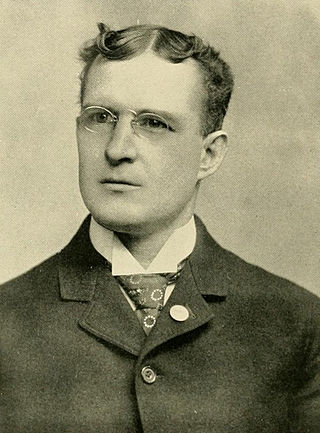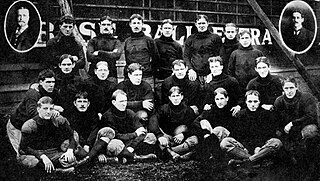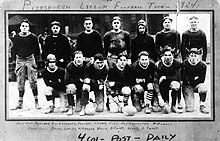
George Washington "Doc" Hoskins was an American football player and coach of football and basketball. He served as the head football coach at Pennsylvania State University (1892–1895), the University of Pittsburgh (1896), and Bucknell University, compiling a career college football record of 59–48–9. Hoskins was also the head basketball coach at Bucknell from 1908 to 1911, tallying a mark of 21–14.
The Western Pennsylvania Hockey League (WPHL) was an originally amateur and later professional ice hockey league founded in 1896 and existing through 1909. Based in Pittsburgh, Pennsylvania, the league became the pre-eminent ice hockey league in the United States. It was the first league to openly hire and trade players.
The Pittsburgh Bankers were one of the earliest professional ice hockey clubs. The club was based in Pittsburgh, Pennsylvania and was a member of the Western Pennsylvania Hockey League, the first league to openly hire hockey players, from 1899–1904 and 1907–1909. The team played all of its games at Duquesne Garden, and was involved in the first known trade of professional hockey players.
The Latrobe Athletic Association was a professional football team located in Latrobe, Pennsylvania, from 1895 until 1909. A member of the unofficial Western Pennsylvania Professional Football Circuit, the team is best known for being the first football club to play a full season while composed entirely of professional players. In 1895, team's quarterback, John Brallier, also became the first football player to openly turn professional, by accepting $10 and expenses to play for Latrobe against the Jeannette Athletic Club.
The PittsburghAthletic Club football team, established in 1890, was based in Pittsburgh, Pennsylvania. In 1892 the intense competition between two Pittsburgh-area clubs, the Allegheny Athletic Association and the Pittsburgh Athletic Club, led to William (Pudge) Heffelfinger becoming the first known professional football player. Heffelfinger was paid $500 by Allegheny to play in a game against Pittsburgh on November 12, 1892. As a result, Heffelfinger became the first person to be paid to play football. Allegheny would go on to win the game, 4–0, when Heffelfinger picked up a Pittsburgh fumble and ran it 35 yards for a touchdown. In 1893, Pittsburgh again made history when it signed one of its players, probably halfback Grant Dibert, to the first known pro football contract, which covered all of the team's games for the year.
Charles Robert Shiring was a professional football player from Pittsburgh, Pennsylvania. He began his playing career with the Pittsburgh Athletic Club during the late 1890s and the Homestead Library & Athletic Club in 1901. In 1902, he played for the Pittsburgh Stars of the first National Football League, who ended up winning the league title. Since the Stars consisted of the best professional players from western Pennsylvania at the time, it can be said that Shiring was considered the best at his position, center, in the region. However Shring is best known for playing for the Massillon Tigers from 1903 until 1907. He finally served from 1907 to 1909 as a player-coach for the Pittsburgh Lyceum, Pittsburgh's last championship professional football team, until the 1970s.
The Franklin Athletic Club of Cleveland was a short-lived professional football team based in Cleveland, Ohio from 1903 until around 1909. Franklin played against in "Ohio League" against the early Canton Bulldogs, Shelby Blues and Massillon Tigers. In 1904 the Tigers defeated Franklin 56-6.
Professor Louis Frederick Kirchner, misnamed in some posthumous sources as William Kirschner, was an early football player and physical instructor for the Pittsburgh Athletic Club. He may, or may not, have been one of the earliest professional football players. Even though he had never played football before 1890, he had the ability to learn and adapt to the game quickly. During the 1890s he was viewed as one of the best offensive linemen in Pennsylvania.
JamesM. Van Cleve was an American football player and coach. He was the fourth ever known person to be paid to play the sport. Only Pudge Heffelfinger, Sport Donnelly and Peter Wright were professionals before him. Van Cleve's contract was with the Allegheny Athletic Association for $50 per game for the entire 1893 season.

William J. Kountz Jr. was an American businessman and an early football player and manager for the Allegheny Athletic Association. He gained brief fame as a humorist with his "Billy Baxter" letters.

John Alston Moorehead was an American college football player and coach. He served as the head football coach at the University of Pittsburgh during the 1907 and 1908 seasons; the school known as the Western University of Pennsylvania before 1908. Moorehead applied for the coaching job after being cut off by his father for eloping with his mother's French maid. Prior to coaching at Pittsburgh, He played halfback while attending Yale University, from which he graduated in 1904.
The 1895 Greensburg Athletic Association season was their sixth season in existence. The team finished 9–1–1 or 8–2–1.
The 1891 East End Gyms football season was the second season of competition for the American football team representing the East End Gymnastic Club. In six documented games, the team had a record of 6–0.
The 1894 Pittsburgh Athletic Club football season was their fifth season in existence. The team finished with a record of 5–4.
The 1895 Pittsburgh Athletic Club football season was their sixth season in existence. The team finished with a record of 7–1–2.
The 1896 Pittsburgh Athletic Club football season was their seventh season in existence. The team finished with a record of 2–5–3.

The 1898 Duquesne Country and Athletic Club football season was their fourth season in existence. The team finished with a record of 11–0–1. The team was named the top team in western Pennsylvania. Roy Jackson was the team's captain and coach.
The Western Pennsylvania Professional Football Circuit was a loose association of American football clubs that operated from 1890 to approximately 1940. Originally amateur, professionalism was introduced to the circuit in 1892; cost pressures pushed the circuit to semi-professional status from about 1920 through the rest of its existence. Existing in some form for 48 years, it was one of the longest-lived paying football loops to operate outside the auspices of the National Football League.
The 1895 Duquesne Country and Athletic Club football team was an American football team that represented the Duquesne Country and Athletic Club in the 1895 football season. In their inaugural 1895 season, the team compiled a 4–3–1 record, and won the unofficial Western Pennsylvania Professional Football Circuit championship for the season when they defeated the Pittsburgh Athletic Club on Thanksgiving to end the season.

The 1899 Duquesne Country and Athletic Club football season was the fifth season of competition for the professional American football team representing the Duquesne Country and Athletic Club. The team allowed only one touchdown all season and outscored opponents by a total of 372 to 15 while compiling a 10–0 record. Roy Jackson was in his second year as the team's captain and coach.





